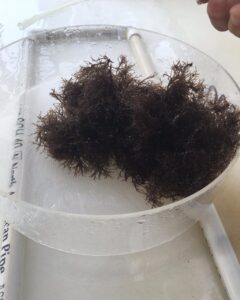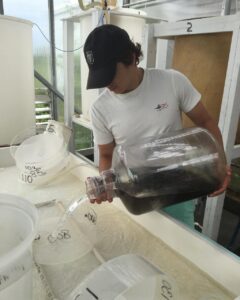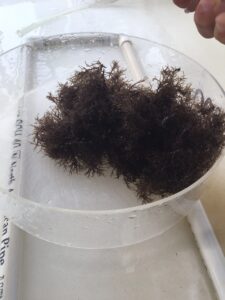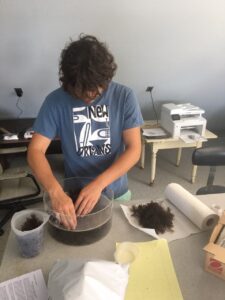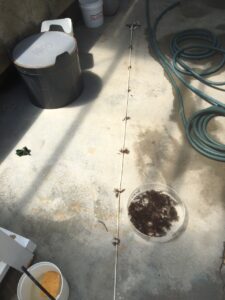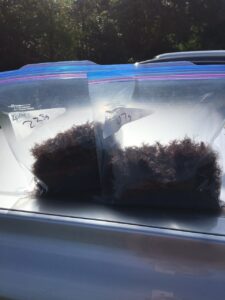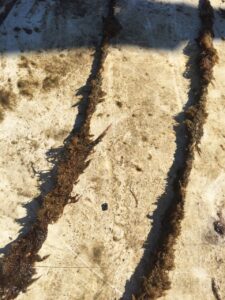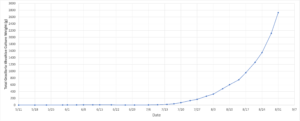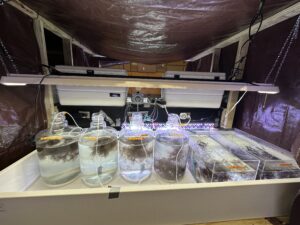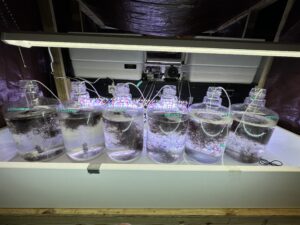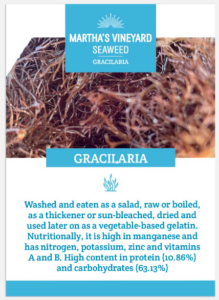Final report for FNE22-019
Project Information
The purpose of our research was to examine if we could successfully grow Gracilaria seaweed on our farm, in hope to bring a summer seaweed product to the seasonal summer tourist market in our area. Gracilaria starter cultures were purchased from Bigelow hatcheries and sent to our partner hatcheries (MVSG,SCSU) for initial grow out until the product became large enough to plant on the farm. As we quickly learned in year one, the Gracilaria took a major health hit when it moved from the hatchery to the farm system. The farm system proved limited, less productive and much less efficient than the hatchery growth operations. The hatcheries in year one were able to successfully maintain Gracilaria cultures throughout the season and we were able to harvest a small amount to use in market research. In year two, in hope of bringing more product to market for market research, we opted not to plant the Gracilaria on the farm, but to instead maintain cultures within the two hatcheries and bring product to market in this way, which proved highly successful. Both hatcheries were able to maintain Gracilaria cultures throughout the summer season, and we were able to harvest and bring this product to our local markets for market research. Marketing materials were created and the harvested product was distributed to clients at the local farmers market and chefs in the area. There was overall interest in the seaweed product with most people finding the texture and taste pleasant, however the majority of people did not know how they would use the product at home or in their restaurant. The product was viewed as a "garnish" that would make a nice place on the side of an oyster appetizer plate or raw bar, or on top of an oyster or a soup. The Gracilaria was valued at a price point similar to other garnishes like parsley. Our research has been shared with the farming community, who expressed interest in the product but are unlikely to grow it as the market is not there for sales. Further attempts could/should be made to find a market such as the pharmaceutical market.
This project seeks to establish a commercial operation for the growth, harvest and marketing of Gracilaria seaweed. We hope to prove the seaweed handbook growout techniques in real world trials, establish a local market for Gracilaria, conduct a market survey to better understand local price and uses for the product, and share our experience with other growers via website, social media and marketing materials.
Year one:
- We will acquire seed source from the hatchery and successfully deploy onto grow lines on the farm.
- We will document and monitor growth rates
- We will begin the first wave of harvesting as the product comes to market size
- We will create a market survey for the product, and distribute this survey and free samples to a wide range of clients, from private chefs to direct consumers at the farmers market.
- We will continue to harvest, monitor and distribute surveys/product throughout the season
- At years end, we will compile survey results, publish all information to our outlets and present findings to MAA farmers.
Year two will build off the success of year one, implementing the feedback from surveys and establishing a price point for products.
Year two results will be shared through our outlets.
The current problem with most shellfish aquaculture operations in the USA is that they are single product farms, predominately growing only oysters. There is a huge need for second and third crops on aquaculture farms to help diversify income streams and protect against crop collapses. Seaweed has seen a huge increase in demand in the last few years, predominantly led by the increased culture of kelp, however no other species have yet to be cultivated. Gracilaria seaweed presents two major opportunities over kelp.
Gracilaria is a warm water seaweed species, which allows for the growth and harvest during the summer months, when New England, especially Massachusetts, the Cape and Islands, sees an enormous influx of tourists visiting the region. This presents an enormous economic opportunity for sales over kelp, which must be harvested before the summer months. A summer seaweed crop is inherently more valuable than a winter seaweed crop.
Gracilaria also contains a large amount of protein content (5-30% on average), which has the ability to supply the growing vegan, vegetarian market, as well as the meat substitute market. Gracilaria is an established crop around the world used in human consumption. It is also a very easy product to grow, which self replicates throughout the season after harvest. Unlike kelp which has a very short season due to cold water requirements, successful propagation of Gracilaria could lead to a potential year round harvest season with numerous value added products and a larger revenue base.
The beauty of Gracilaria is that it can be grown in tandem with shellfish. In fact, the two products when grown together actually benefit each other. In addition, these products benefit and improve the natural bio-diversity sharing the eco-system with these crops. As part of this project, we will also maintain ecosystem monitoring and measure the effect Gracilaria cultivation has on the local eco-system. This ecosystem data is part of an ongoing research partnership with WHOI and Southern Connecticut State University.
Following our successful cultivation and harvest of the product, we will also conduct market outreach. We will create a survey for direct consumer farmers market clients and well as professional chefs that will help us identify price points, recipes and uses of the product. We anticipate the survey results to help us establish price points, recipes and value added products that we can share with industry. As part of this grant, we will establish a dedicated website to share our results, as well as utilize our social media outreach (3500 followers) to share our results. As a trustee of the Massachusetts Aquaculture Association, I also plan to present the results of our project to other farmers within the State.
Our hope is to establish Gracilaria as a permanent crop in our farm system, and inspire other farmers to grow Gracilaria. Our technical advisor, Prof. Yarish will be instrumental in aiding us, as will our network of quality chefs. We feel Gracilaria will become an exciting product in the aquaculture industry to help diversify crop and revenue for farmers while providing the food scene with an exciting new product that not only helps improve local environments but also combats climate change through carbon sequestration.
Cottage City Oysters has operated an aquaculture farm in Oak Bluffs off the coast of Martha's Vineyard since 2014. The farm specializes in producing the high quality Cottage City Oyster, which is sold exclusively on Martha's Vineyard and at select high end establishments around the country. The farm has experimented with growing various other products such as kelp, gracilaria, bay scallops, butter clams and little neck clams and has tested/sold these products through it's various outlets including retail establishments on island, farmers markets, direct to consumer catering events and their internationally recognized farm tours. Farm resources utilized in this project include multiple work vessels, rafts and platforms, wholesale facilities, media outlets and retail outlets.
Cooperators
- - Technical Advisor (Researcher)
- (Researcher)
- - Technical Advisor (Educator)
Research
We purchased Gracilaria from Bigelow Labs and on April 15th, 2022 had it delivered directly to our partnering hatcheries, MV Shellfish Group and Southern Connecticut State University. Following the seaweed handbook procedures and help from our mentor Prof. Charles Yarish, the hatcheries setup a cultivation system and began growing the gracilaria to market size.
Measurements were taken from both hatcheries weekly throughout the growing season to compare growth rates.
As product came to market size, we began to experiment with planting the gracilaria into "the wild" on the farm, as well as testing product with chefs and consumers via our wholesale, retail and direct to consumer markets.
Gracilaria on the farm was measured for growth but found to have fouled and ultimately die just a week after planting. We suspect the hatchery conditions were ideal (light, circulation, food, no other organisms) when compared to the farm site- and therefore the crop stunted and died when planted. This taught us that hatchery cultivation was the preferred process of growth as it was much less labor intensive and produced ideal quality product.
Two Gracilaria cloned fragments were purchased from Bigelow labs. One fragment given to MV Shellfish Group (MV) hatchery and the other to Southern Connecticut State University (SCSU) hatchery. The intent was to grow the culture large enough for out planting on the farm site. As the hatchery growth trials got underway we conducted weekly weighing and cleaning of the product and returning the product into a fresh culture container. We saw growth immediately with the fragments (See data sheets). On week 4, a catastrophe occurred in the MV hatchery in which too much cleaning solution was used. The entire culture was destroyed. Luckily, the SCSU culture was producing wonderful growth and we were able to supply the MV hatchery with another piece of Gracilaria from the SCSU stock. We quickly recognized that hatchery propagation of the Gracilaria product would be successful and decided to maintain hatchery culture growth for the entire season. Small fragments of the cultures were suspended in each hatchery to use as a starter if another catastrophe occurred. Our year one goal for hatchery growth was to see how large and how quickly we could build up the mass.
In July we began "harvesting" Gracilaria from the hatcheries to begin our market survey. Product was given to island restaurant and private chefs, as well as the general public via our farm market stand. General feedback was positive. Chefs liked the taste, color and texture of the product, however found it difficult to use in recognizable plates. Most chefs agreed that it would likely be used as a garnish, seasoning or small side element to complement another dish. The general public at the farmers market on the other hand recognized the product for use in soups, salads, smoothies, dried seasoning and even as a skin care element in a bath! There was very positive interest. We attribute these uses/knowledge of Gracilaria because of our Sugar Kelp seaweed product and the similar uses with it.
In August we seeded a line of Gracilaria (following the Seaweed handbook instructions) with strands from MV and deployed the vertical grow line into the nursery in the Lagoon. The strands were placed every foot along the line in attempt to determine best depths for growing Gracilaria. Die back of the Gracilaria was immediately noticed a week later, most likely due to nutrient deficiency and lack of oxygen in the pond compared to the hatcheries "prime" growing conditions. By week two, the grow line was completely fouled with other organisms and the Gracilaria was unable to recover.
Regular harvests from the hatchery stock continued throughout the Summer and even into October. The entire culture was harvested from MV in September and a small fragment was suspended to see if we can revive the stock next Spring. SCSU is going to continue to try to growth their culture through the entire winter and will monitor changes in growth as cold winter approaches.
Year two trials continued in the Spring of 2023 as two new Gracilaria cultures were purchased from Bigelow labs and distributed to our hatchery partners, MVSG and SCSU. Using our findings from year one and consultation with our mentor over the winter, it was decided to forego plantings on the farm and to instead focus growth from our proven year one hatchery success. Using the data and experience from year one, the hatcheries were able to improve growth success with the cultures which allowed for us to harvest and trial Gracilaria to our markets throughout the summer season. For our marketing trials, we created a flyer to hand out with samples. Samples were made available throughout the summer, at festivals, farmers markets and raw bars and restaurants. Chefs and clients showed a liking for the product, however it was established that beyond a seaweed salad, folks didn't know what to do with it.
We were very successful in growing the Gracilaria to market via the hatcheries. Outplanting on the farm was unsuccessful due to biofouling and less than ideal conditions when compared to hatchery conditions. It was determined that growth and harvest in the wild would never be as productive as growth and harvest in a hatchery. Hatchery propagation of Gracilaria is by far way more productive than planting in the wild. Highly productive masses of Gracilaria can be obtained in a hatchery setting with relative ease using simple off the shelf lighting, aeration and food. While production of Gracilaria in the hatchery was met with little problems, marketing and distributing the product proved problematic.
Over the two years, product was successfully harvested for the market and distributed over the summer months to various end users such as chefs, farmers markets, private events, raw bars, festivals, tours and the general public. The Gracilaria was well received by all parties. Everyone who tried the product enjoyed the texture and taste, however chefs and the general public were unable to find ways to incorporate the product into main dishes. "Seaweed salad" was the most common answer when asked how folks would use it.
Consensus from chefs is that the product is limited to garnish/seasoning type uses, and should be priced as such (priced like cilantro, basil, parsley, etc). At the farmers market, a niche group of clientele who seek out the health benefits of seaweed were willing to pay a premium price for the product (similar to kelp). The general public seemed uneducated about the uses of seaweed in food, however they enjoyed the look, texture and taste of the Gracilaria. We concluded that further market research could be useful to determine other avenues for the product, such as the cosmetic industry, or pharmaceuticals.
Education & Outreach Activities and Participation Summary
Participation Summary:
A presentation of our year one findings, followed by a Q&A session was given at the Massachusetts Aquaculture Association Annual Meeting.
In addition, a webpage was created for the project where our results have been posted.
Multiple social media and newsletter blasting about the project have advertised the webpage as a resource.
Year two results are scheduled to be presented at the Massachusetts Aquaculture Association Annual Meeting. The social media and website have been updated with year two results.
https://vineyardgazette.com/news/2022/07/14/growing-taste-vineyard-seaweed
Learning Outcomes
Most farmers were unaware of Gracilaria as a possible crop species and unaware of the growing/harvesting process.
Project Outcomes
The teams at both the MV Shellfish Group hatchery and Southern Connecticut State University hatchery gained valuable experience growing, maintaining and harvesting Gracilaria as a part of the project. Labs were equipped with necessary materials for the project and new skills were learned. Interns, managers, biologists, farmers and professors all contributed to the project, learning a great deal about the Gracilaria species and the attributes it requires for optimum growth. The data sets collected as part of the year one project will aid the hatcheries to produce Gracilaria more efficiently in year two.
The failure of the out-planting onto the farm was disappointing but in hind sight makes complete sense. Variables in the "wild" will never be as optimal as hatchery conditions. Harvesting from the wild will never be as easy or efficient as harvesting from a hatchery container. I believe we might be able to overcome the out-planting challenges faced in year one by out-planting Gracilaria onto the farm much sooner in the season. Hopefully an earlier establishment on the farm will allow the Gracilaria to outcompete fouling organisms. In addition, we plan to place Gracilaria strains in a different farm container (floating bin), to see if production can compete with hatchery production rates.
The market survey results were similar to the results we have received with other seaweed products. A very niche group of educated individuals are willing to pay a premium price for the product because of the perceived health benefits of seaweed consumption. We believe this niche group will continue to grow in the decades to come as the general public continues to learn about the health benefits of seaweed. Chefs and the general public were mostly unaware of Gracilaria, and came to view the product as a garnish or seasoning type product; something to add on top or into something else.
An added bonus of this project is the number of students who have worked on it. Through this project and the SCSU class, we've created experiences in husbandry, strengthened relationships between all stakeholders, developed new collaborations between high school (Common Ground High School in New Haven) and SCSU and generated interest in exploring other seaweed species to expand seaweed aquaculture.
I believe our approach was spot on. By utilizing two hatcheries for culture growth we were able to hedge our success against any missteps, as proven by our ability to recover from the catastrophic failure at the MV hatchery. The successful recovery of the MV culture (cloned from the SCSU culture) allowed the experiment to continue as planned.
Growth rates were much faster in the hatchery than anyone anticipated. Measurements with a ruler proved to be problematic and inaccurate due to the organic way Gracilaria grows. We opted to change growth measurements to a weight based system, which proved very accurate. A hatchery focused on Gracilaria production would be able to grow a large mass of product in a relatively short time.
There is concern about the demand of the product. Demand is virtually zero. The "seaweed niche crowd" was open to, and welcoming of the new product, however this group is too small to justify Gracilaria production. For an entity to be profitable at Gracilaria production, additional markets will need to be explored.
We have also hypothesized a small hatchery type setup for farmers or fish markets; A wet storage type system that a fish market could maintain (like a lobster tank) to keep an ever growing culture of Gracilaria available for harvest on demand. The creation of a small pilot wet storage setup for Gracilaria culture would be an interesting project to provide a fish market harvestable Gracilaria to customers on demand. We do not have funds to follow through on this concept, however it may make for an interesting future grant.
Most importantly we need to examine market demand and restaurant implementation. There is currently not enough demand to justify Gracilaria production in the hatchery or the farm. New markets need to be explored.
